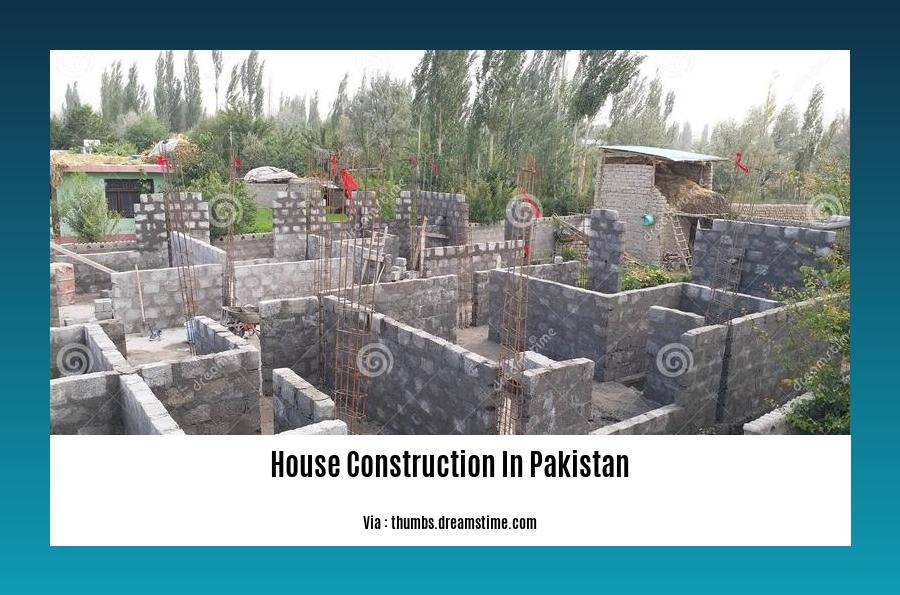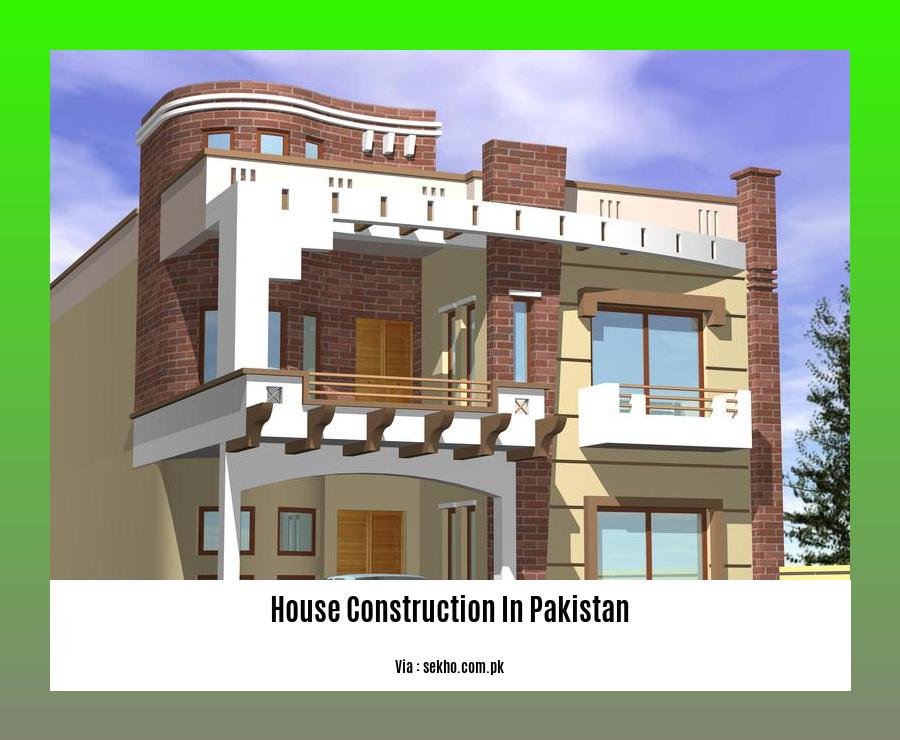Embark on a comprehensive journey through the intricacies of house construction in Pakistan with our meticulously crafted guide, “House Construction in Pakistan: A Comprehensive Guide for Homeowners.” Delve into the nuances of construction practices, unravel the latest trends, and discover innovative solutions to create your dream home in the vibrant tapestry of Pakistan’s architectural landscape.
Key Takeaways:
- Conduct soil analysis for a stable foundation.
- Design a detailed floor plan with architects or designers.
- Register for necessary utility services.
- Excavate and concrete the foundation base.
- Select materials and finishes for the exterior.
- Plan the interior layout and décor.
- Install fixtures, appliances, and complete finishing touches.
- Obtain building permits and comply with regulations.
- Use a cost calculator to estimate construction expenses.
House Construction in Pakistan

Building a home in Pakistan is a significant undertaking. Whether you’re a first-time homeowner or a seasoned builder, navigating the complexities of house construction in Pakistan can be daunting. This comprehensive guide will break down the process into manageable steps, helping you build your dream home with confidence.
Materials and Planning
Choosing the right materials is crucial. Wood is popular for its affordability, while bricks offer durability. Cement forms the backbone of any structure. A well-thought-out floor plan is essential for a functional home. Work with architects or designers to create a layout that meets your needs.
Legal Considerations
Obtain all necessary building permits and ensure compliance with local regulations. Register your property with the relevant authorities. Neglecting these steps can lead to penalties or legal issues.
Step-by-Step Construction
- Soil Analysis: Determine the soil type for a stable foundation.
- Excavation and Foundation: Excavate the site and pour the concrete base.
- Walls and Structure: Build walls according to your design and choose appropriate materials.
- Roofing: Install a durable roof that can withstand Pakistan’s climate.
- Windows and Doors: Choose windows and doors that provide ventilation, light, and security.
- Interior Design: Plan the layout and décor for each room, making your home comfortable and stylish.
- Finishing Touches: Install fixtures, appliances, and paint to complete your home.
Cost Estimation
Use online cost calculators to estimate expenses based on location, size, and material quality. Factors like labor costs and material availability can impact the final price.
Professional Advice
Consider hiring professionals for tasks like design, construction, and legal matters. Their expertise can save you time, money, and ensure a high-quality home.
Building a home in Pakistan requires careful planning, legal compliance, and quality construction. By following these guidelines and seeking professional guidance when needed, you can turn your dream home into a reality.
Are you curious about house construction costs in Ireland? Click on the link to read more about the topic. If you’re planning to construct a house in the magnificent landscape of Kerala, you don’t want to miss our detailed guide on house construction in Kerala. For those considering building a home in the beautiful island nation of Sri Lanka, we highly recommend exploring our comprehensive article on house construction in Sri Lanka. And if you’re looking to build your dream home in the vibrant Philippines, be sure to check out our informative piece on house construction in the Philippines.
Sustainable Practices and Energy Efficiency

Key Takeaways:
- Pakistan is prioritizing energy-efficient buildings to reduce household energy consumption.
- Energy-efficient practices can lower pollution and increase profits.
- Pakistan is investing in sustainable infrastructure with minimal environmental impact.
- Awareness and funding are crucial to promote sustainable construction.
Embracing Energy Efficiency in Pakistan
Pakistan is making significant strides in implementing energy-efficient practices in the construction industry. The government has introduced policies aimed at reducing household energy consumption, and organizations like the LUMS Energy Institute are actively promoting energy-efficient solutions. By adopting these practices, Pakistan can not only reduce its energy footprint but also generate economic benefits.
Benefits of Sustainable Construction
Energy-efficient buildings not only conserve energy but also provide a range of advantages:
- Lower utility bills and increased profitability
- Reduced environmental impact by minimizing greenhouse gas emissions
- Enhanced occupant comfort and well-being
- Increased property value and market demand
Challenges and Opportunities
While Pakistan is committed to sustainable construction, there are challenges to overcome, such as:
- Lack of awareness about the benefits of energy efficiency
- Limited funding for sustainable building projects
- Absence of standardized building codes and regulations
To address these challenges, Pakistan needs to invest in education and awareness campaigns, provide financial incentives for sustainable construction, and develop comprehensive building codes.
The Future of Sustainable Construction
Pakistan is well-positioned to become a leader in sustainable construction. With its abundance of renewable energy sources and growing awareness of the importance of environmental protection, the country has the potential to create a thriving and sustainable built environment.
Relevant URL Source:
Architectural Styles and Design Considerations
When it comes to architectural styles and design considerations, Pakistan offers a fascinating blend of tradition and modernity. From intricate jaalis to sleek contemporary designs, there’s a style for every taste and lifestyle.
Traditional Architectural Influences
Pakistan’s rich history has left an indelible mark on its architecture. Courtyard designs, inspired by the warm climate, create private outdoor spaces within homes. Jaalis, lattice screens that adorn windows and balconies, provide privacy and ventilation.
Modern Architectural Trends
Contemporary architecture has made its presence felt in Pakistan, with simple and clean designs that emphasize functionality. The international style, with its focus on minimalism and open floor plans, has gained popularity. Minimalist architecture, with its sparse ornamentation and emphasis on space, has also found a following.
Elements of Pakistani House Design
Certain elements are common in Pakistani house design. Vaulted ceilings add height and drama to living spaces. Spacious interiors provide ample room for families and guests. Arches and domes, reminiscent of traditional architecture, can add a touch of grandeur.
Popular Styles in Pakistan
Contemporary Architecture: Characterized by clean lines, open spaces, and a focus on functionality.
Modern Architecture: Embraces simplicity and minimalism, with an emphasis on natural light and ventilation.
Minimalist Architecture: Strives for a pared-back aesthetic, with a focus on essential elements and a lack of ornamentation.
Key Takeaways:
- Traditional Pakistani architecture blends courtyard designs and jaalis with modern influences.
- Contemporary, modern, and minimalist architecture styles are gaining popularity.
- Pakistani house designs often feature vaulted ceilings, spacious interiors, and arched or domed elements.
- The choice of architectural style depends on individual taste, lifestyle, and climate considerations.
Most Relevant URL Source:
- Most Common House Construction Styles in Pakistan
Legal and Administrative Procedures
When embarking on a construction project in Pakistan, navigating legal and administrative procedures is paramount for a smooth and compliant process. Here’s a concise guide to help you understand the essentials:
Planning and Permits
- Building Plan Approval: Submit construction plans to the relevant local authority for approval, ensuring compliance with building codes and regulations.
- Building Permit Acquisition: Obtain a building permit from the local authority after plan approval, authorizing the commencement of construction.
Property Ownership and Transfer
- Property Title Verification: Conduct a thorough title search to confirm the property’s legal ownership and identify any encumbrances.
- Transfer of Property: Execute a sale deed or gift deed to transfer ownership legally, ensuring proper documentation and registration.
- Property Taxes: Pay property taxes regularly to the relevant authorities to maintain ownership and avoid penalties.
Construction Management
- Construction Contracts: Draft clear and comprehensive contracts with contractors, outlining project scope, timelines, and payment terms.
- Site Supervision: Engage qualified professionals to oversee construction progress, ensuring adherence to plans and building regulations.
- Construction Completion Certificate: Obtain a completion certificate from the local authority upon project completion, certifying compliance with approved plans and safety standards.
Key Takeaways:
- Legal and Administrative Procedures play a crucial role in house construction in Pakistan.
- Understanding these procedures helps ensure compliance and avoids potential legal issues.
- Due diligence in verifying property ownership, obtaining permits, and managing construction contracts is essential.
- Property taxes must be paid regularly to maintain ownership and avoid penalties.
- Engaging qualified professionals and obtaining necessary certificates ensures safety and compliance.
Most Relevant URL Source:
FAQ
Q1: What are the first steps to start building a house in Pakistan?
A1: The initial steps involve soil analysis, creating the house layout, and registering for utility services.
Q2: What are the essential materials used in house construction in Pakistan?
A2: Commonly used materials include wood for its affordability, bricks for durability, and cement for structural stability.
Q3: What are some key architectural influences on house designs in Pakistan?
A3: Traditional designs incorporate elements like courtyards and jaalis, while modern trends include contemporary, international, and minimalist styles.
Q4: How can I estimate the cost of building a house in Pakistan?
A4: Online cost calculators can provide an estimate based on factors such as location, size, and material quality.
Q5: What legal requirements should I be aware of when building a house in Pakistan?
A5: Obtaining building permits, complying with codes, and registering the property with relevant authorities are crucial legal requirements.
- Dora the Explorer Wipe-Off Fun: Safe & Mess-Free Activities for Little Explorers - April 18, 2025
- Does Lemongrass Repel Mosquitoes? Fact vs. Fiction + How to Use It - April 18, 2025
- Do Woodchucks Climb Trees?Fact vs. Fiction - April 18, 2025










